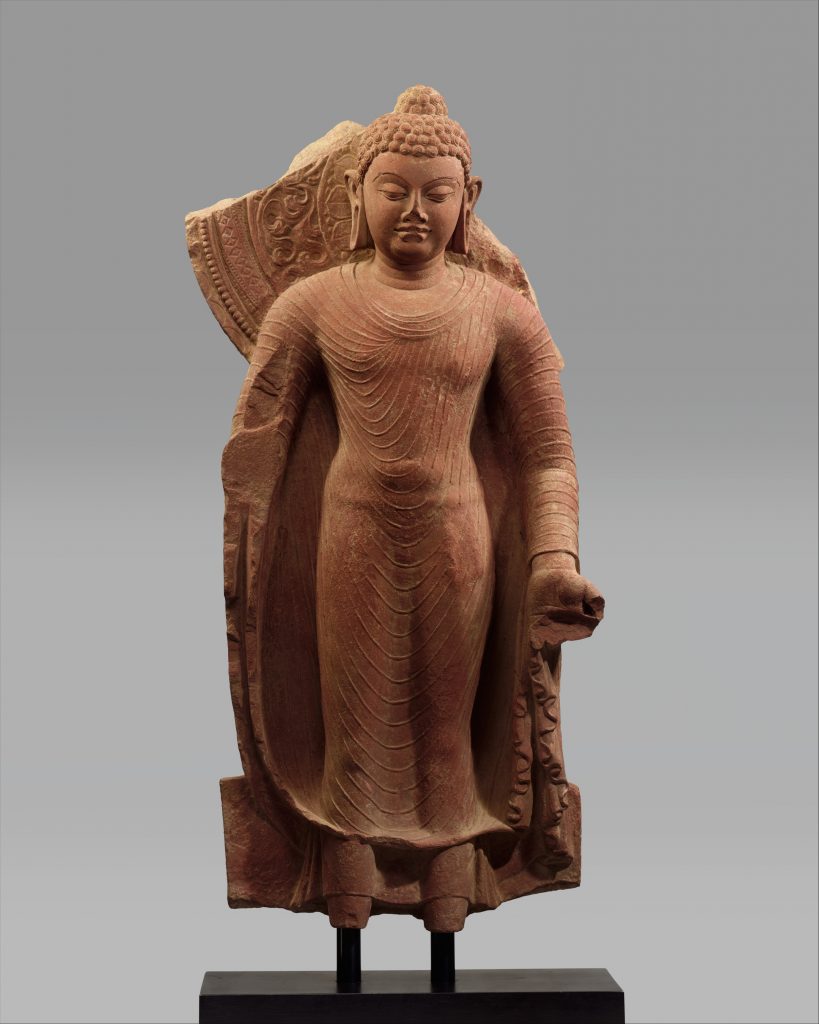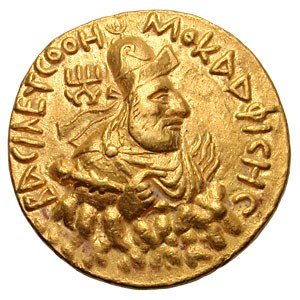Coins of Gupta Dynasty/Golden Age of India
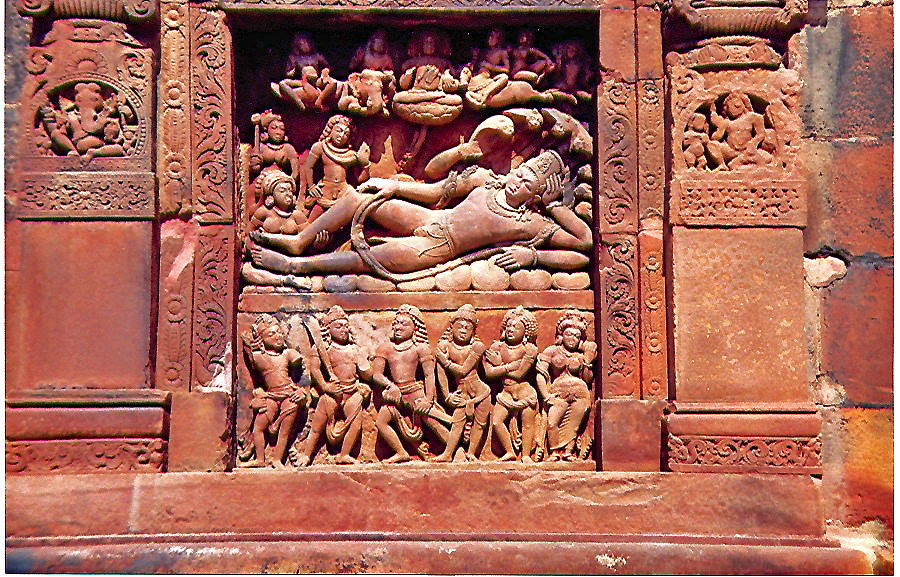
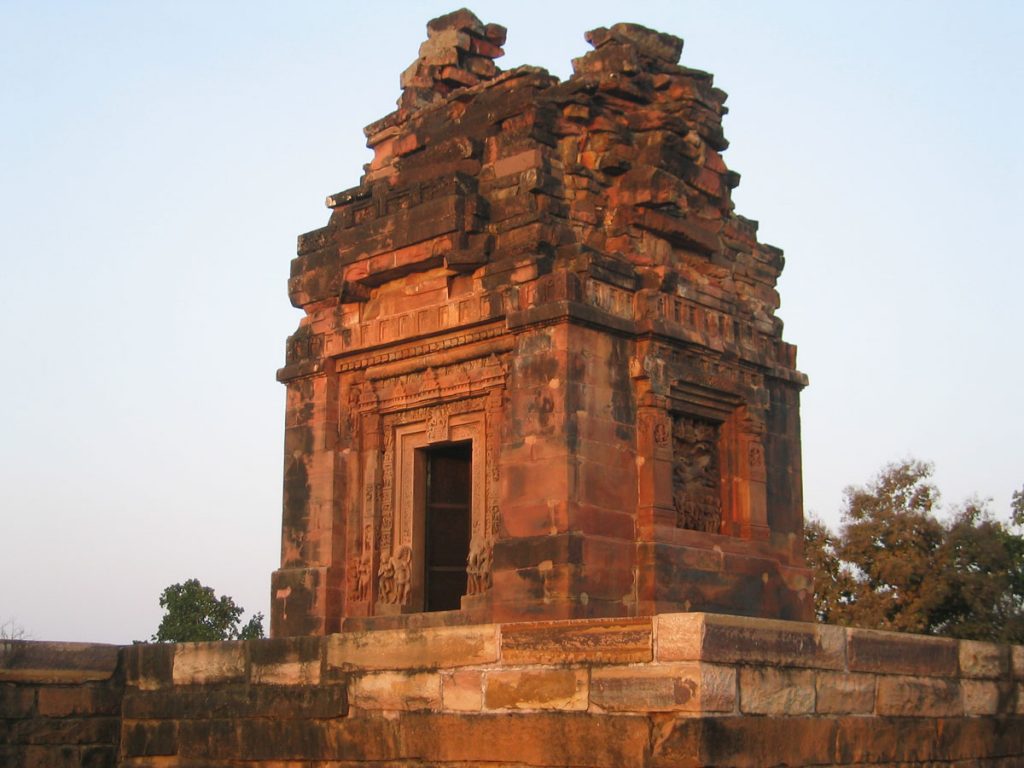
By the fourth century AD, political and military turmoil destroyed the Kushan empire in the north and many kingdoms in the south India. At this juncture, India was invaded by a series of foreigners and barbarians or Mlechchhas from the north western frontier region and central Asia. It signaled the emergence of a leader, a Magadha ruler, Chandragupta I. Chandragupta successfully combated the foreign invasion and laid foundation of the great Gupta dynasty, the emperors of which ruled for the next 300 years, bringing the most prosperous era in the Indian history.
The reign of Gupta emperors can truly be considered as the golden age of classical Indian history. Srigupta I (270-290 AD) who was perhaps a petty ruler of Magadha (modern Bihar) established Gupta dynasty with Patliputra or Patna as its capital. He and his son Ghatotkacha (290-305 AD) have left very little evidences of their rule and did not issue any coins of their own (although there have been reports of coins of Shrigupta which need thorough studies). Ghatotkacha was succeeded by his son Chandragupta I (305-325 AD) who strengthened his kingdom by matrimonial alliance with the powerful family of Lichchavi, who were rulers of Mithila kingdom. His marriage to Lichchhavi princess Kumaradevi, brought an enormous power, resources and prestige. He took advantage of the situation and occupied whole of fertile Gangetic valley. Chandragupta I eventually assumed the title of Maharajadhiraja (emperor) in formal coronation.
Most probably Chandragupta I never minted gold coins of his own, although some historians believe that gold coins depicting king (Chandragupta) and queen (Kumardevi) are minted by him. It is very likely that these coins were minted by their illustrious son, Samudragupta. Shown below is very nice example of this special coin where Chandragupta and Kumardevi are shown (without halo). Chandragupta is offering a ring (or putting Sindur) to his queen Kumardevi. Chandra in Brahmi script is written below left arm of King, while Shri-Kumardevi is written near right hand of queen. Reverse of coin shows goddess Ambika, sitting on Lion. The legend on reverse reads Lichchavyah, which suggests that indeed, Samudragupta took pride in being son of Lichchavi princess. His affection towards his parents is amply demonstrated while issuing this superb (commemorative?) gold coin. This coin is a rare and very special in Indian numismatics.
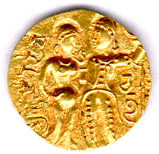
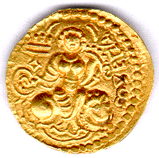
Kumardevi and Chandragupta I
(Minted by their son Samudragupta) 335-370 AD
Gold Dinar Weight: 7.8 gm
Obverse: King and queen
Reverse: Goddess Ambika (Durga) sitting on lion
Reference: Altekar#1
Rare
On Right is a sculpture of Ambika/Durga sitting on her vehicle, Lion. This sculpture made in 9th Century, found in modern Uttar Pradesh, which was part of Gupta empire, clearly show that Gupta die-makers were acutely aware of contemporary art and may even have influenced artists for generations to come. This beauatiful sculpture is currently housed in Metropolitan Museum of Art, New York, and shows striking resemblance to the reverse of the coin.

SAMUDRAGUPTA (335-380 AD)
Samudragupta was the first of the four great emperors of the Gupta dynasty. His name appear in Javanese text `Tantrikamandaka‘, and Chinese writer, Wang-hiuen-tse refers that a ambassador was sent to his court by King Meghvarma of SriLanka, who had asked his permission to build a Buddhist monastery at Bodh Gaya for the monks traveling from SriLanka. But the most detailed and authentic record of his reign is preserved in the rock pillar of the Allahabad, composed by his court poet, Harisena. Written in Sanskrit language in Brahmi script, this inscription is considered as the most important document of the Gupta age.
Samudragupta enlarged the Gupta Kingdom by winning a series of battles till he was a master of Gangetic plains. Soon he defeated the kings of Vindhyan region (central India) and Deccan. He although made no attempt to incorporate the kingdoms of south of Narmada and Mahanadi rivers (southern India) into his domain. When he died his empire bordered with Kushan of Western province (modern Afghanistan and Pakistan) and Vakatakas in Deccan (modern southern Maharashtra). Samudragupta after all his military triumphs, performed the Ashwamedha Yagna (Horse sacrifice ceremony), which is evident on some of his coins (shown below). Ashwamedha Yagna gave him the coveted title of Maharajadhiraj, the supreme king of kings. His greatest achievement can be described as the political unification of most of the northern & central India or Aryavarta into a formidable power.
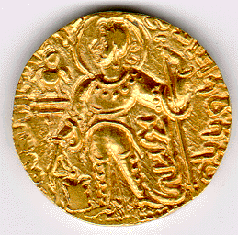
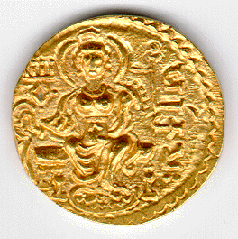
Samudragupta 335-370 ADGold Dinar (Standard type or Royal Sceptre type)Weight: 7.7 gm Obverse: King sacrificing at altarReverse: Laxmi sitting holding diadem in right hand and cornucopia in left handReference: MAC#4773 ff
Most certainly, Samudragupta is the father of Gupta monetary system. It is very likely that, the Kushan gold coins were circulating in the north and central India (possibly in the eastern India too), the dominion which comprised of Samudragupta’s empire. It was these Kushan coins which were the source of inspiration for Samudragupta. When he introduced the first Gupta coinage, they were of the same weight standard as that of Kushan. The Kushan rulers had adopted Roman standard and minted their coins as 8 gms unit, which were called as Dinara, derived from Roman name for their gold coins, Denarius Aureus. Thus, the Gupta gold coins were also named as Dinara and referred by that name in most contemporary literature. Interestingly, this obviously foreign weight standard (122.9 grains) was not very satisfactory for the rulers, thus a conscious effort was made by later Gupta rulers to mint coins in Indian weight standard, popularly called Suvarna. The Suvarna weight standard suggests coin of 144 grains or approximately 9.2 gms of gold. Finally, it was Skandagupta who succeeded in minting Gupta gold coins in Suvarna standard (commonly called as heavy type gold coins).
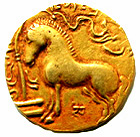
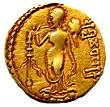
Samudragupta
Gold Dinar, Weight: 7.6 gm
Obverse: Uncaparisoned horse standing to left before yupa (a sacrificial post), Yupa has pedestal in two steps. A pennon fly from Yupa, top over the horse. The mane of the horse is probably plaited with a string of golden beads. Letter Si is under the horse, standing for Siddham. The legend reads Rajadhirajah Prithvimavitva divam jayatyaha-ritavajimedhah.
Reverse: Crowned the chief queen (Mahashi) standing not nimbate, (most coins have queen nimbate) , holding in her right arm a chauri over right shoulder and in her left hand a towel, hanging by her side. A lotus is under her feet. Suchi, a sacrificial spear appear before queen. The legend reads Ashwamedhaparakramah
Reference: Altekar plate VI, 3; BMC plate V 9, MAC#4787
Rare
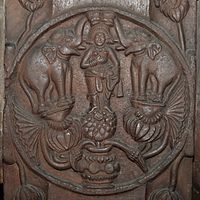
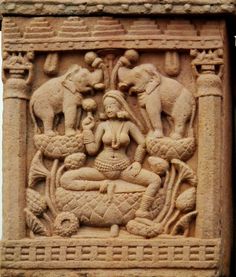
Samudragupta paid considerable attention and left an extensive coinage. Samudragupta minted seven distinct types of coins: standard type, the archer type, Battle Axe type (refers to his military activities), Ashwamedha type (Commemorating the horse sacrifice ceremony) , tiger slayer type, King and queen type (shown above) and Lyrist types (shown below).
All Gupta emperors minted beautiful gold coins which have evoked widespread admiration for their technical and sculptural finesse. Significantly, these coins are minted with meticulous planning, reflected in the fine details and the volume of message that these coins provides. Most Gupta gold coins weighed close to 7.6-8.0 grams and had Sri-Laxmi (goddess of wealth) depicted on reverse side of the coin. Both the weight standard and the concept of presence of deity on coins is almost certainly borrowed from the late Kushana gold coinage. The symbols, phrasing of Sanskrit legends (written in Bramhi script), size, weight and gold content in their coins appears to have been meticulously planned and executed.
The second coin shown above is a `Standard or Royal Sceptre type’ coin, which depicts Samudragupta, a tall man with sharp features making an offering at an altar with his right hand, and his left hand holds the Standard or royal sceptre (Rajadanda). The king sacrificing at altar was the common obverse design on Vima’s and Kanishka’s coins, and later Kushan rulers too used this motif almost exclusively. Below his left arm his name Samudra is written, while legends at edge of coin reads Samara Sata Vitata Vijayo Jita Ripurajito Divam Jayati (the invincible king who had won hundred battles). The Gupta emblem, Garuda, a mythical bird, also considered as a vehicle of Lord Vishnu (husband of Sri Laxmi) is seen on the left. The legends are in Sanskrit written in Brahmi script. On reverse is Sri-Laxmi (the goddess of wealth) seated on throne. The legend on right reads Parakramah in Brahmi. This is one of the earliest issue of Gupta gold staters or Dinara.
Laxmi or Lakshmi (also known by her other names such as Sri or Sridevi) is part of the trinity, the Tridevi, with Parvati (Ambika) and Saraswati being other two goddesses. Although first mentioned in Rigveda and Atharvaveda, composed around 1000 BC, the earliest iconographic evidence of Laxmi is mostly seen as Gaja-Laxmi, accompanied by two elephants (Gaja means elephant) at two ancient places, Bharhut stupa, built during Mauryan-Shunga period, 2nd centiry BC (top image) and Sanchi Stupa, built by Mauryan-Shunga and Satavahana dynasties (199-100 BC) (lower image). Here she is shown either standing or sitting on lotus, holding flower in her hand. Elephants are associated with opulence, and Laxmi is shown to be showered by gold(?) coins by elephants, an apt depiction of goddess of wealth. Being widely accepted image since Mauryan period, Gupta rulers first issued gold coins with Laxmi, a masterstroke by Samudragupta. This remained as the most iconic symbol on gold coins for another 700 years!
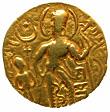
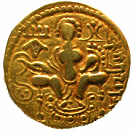
Samudragupta
335-370 AD
Gold Dinar, Weight: 7.6 gms
Obverse: King, standing looking left, holding battle-Axe (Parashu) with his left hand, resting right hand on hip. A dwarf looking upto him and standard at the left of flan. Brahmi legend `Samudra’ below his arm.
Reverse: Goddess Laxmi nimbate, enthroned holding cornucopiae and a bouquet of flower, symbol to left, to right the Brahmi legend `Krtantaparasuh’
Reference: BMC plate IV, 8-9; Altekar plate V, 6
Rare
Beyond doubt Samudragupta was a great military general, but apart from that, his personal accomplishments are equally remarkable. He showed great magnanimity towards those kings who were defeated. His polished intelligence and good knowledge of scriptures won him many admirers. He gathered a galaxy of poets and scholars and took effective actions to foster and propagate religious, artistic and literary aspects of Indian culture. He had good proficiency in music and was perhaps an accomplished Lyrist (Lyre or Veena is a musical instrument). This fact is amply demonstrated in his lyrist type coins. Most king took pride in trumpeting their bravery, but Samudragupta is the only king of Indian history who showed softer side of his personality (Kumargupta, his grandson, have copied this type and minted few Lyrist type gold coins, which are rare). These coins are very special and rare. Shown below is this coin where Samudragupta is shown playing Lyre or Veena, a kind of harp like string musical instrument. The legends on obverse in margin reads Maharajadhiraja Shri Samudragupta. The legends are in Sanskrit, written in Brahmi script.
Shown above is his `Battle Axe’ type of coin, where King is shown standing looking left, holding battle-Axe (Parashu) with his left hand, resting right hand on hip. A dwarf looking up to him and standard at the left of flan. Brahmi legend `Samudra‘ below his arm. On reverse is Goddess Laxmi nimbate, enthroned holding cornucopiae and a bouquet of flower, symbol to left, to right the Brahmi legend `Krtantaparasuh‘
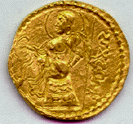
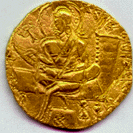
Samudragupta
Gold Dinar
Weight: 7.9 gm
Obverse: King playing Veena or Lyre
Reverse: Laxmi sitting
MAC#4788-90
Rare
VIKRAMADITYA or CHANDRAGUPTA II (380 to 413 AD)
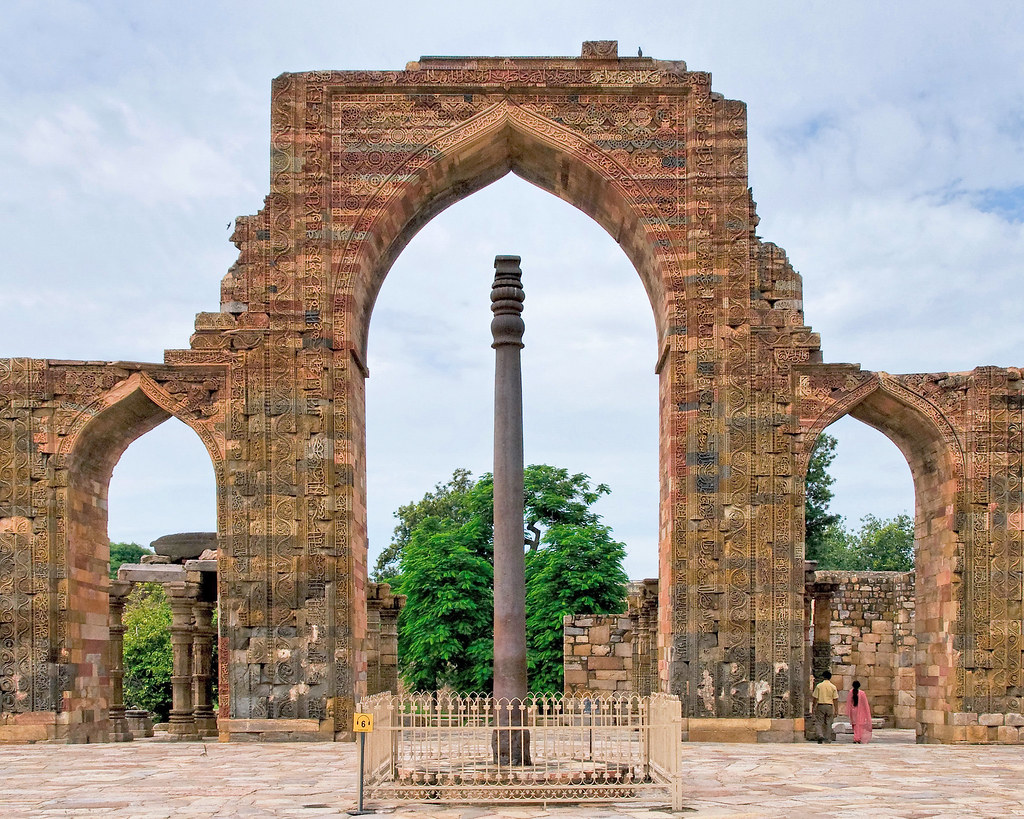
It is very apt to say, like father like son. Samudragupta’s son, Chandragupta II tried to be better than his father, and most historians agree, he was certainly successful. Vikramaditya is THE LEGENDARY emperor of India. More stories/legends are associated with him than any other ruler of India. It was during his (and his son Kumargupta) reign, India was at the pinnacle of prosperity and opulence. Although named after his grandfather Chandragupta, he took a title of Vikramaditya, which became a synonym for sovereign of tremendous power and wealth. This title was later taken up by scores of other sovereign rulers of India.
Vikramaditya succeeded his father Samudragupta (possibly there was another prince, or his elder brother who ruled briefly, and according to legends slayed by Shakas), and carried on the policy of `world conquest’ of his predecessors. Political marriages occupied a prominent place in foreign policy of Gupta emperors. He married princess Kubernaga, daughter of Naga Chieftains and later gave his daughter Prabhavati in marriage to Rudrasena of powerful family of Vakatakas of the Deccan (modern Maharashtra).
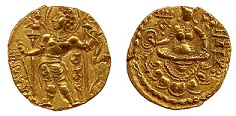
Vikramaditya or Chandragupta II
375-414 AD
Gold Dinar, Weight: 7.77 gm
Obverse: King holding Bow, looking right
Reverse: Laxmi sitting on lotus
MAC#4796 ff
Rare
Vikramaditya’s most significant and well celebrated military achievement is the total destruction of Kshatrapas, the Shaka (Scythian) rulers of Malawa and Saurashtra, the western India (modern Gujrat and neighboring states, including part of northern Maharashtra). He scored a fantastic victory over the Kshatrapa rulers and incorporated these provinces into his increasing empire. The cool courage that he showed in fight with Shakas and killing their king in their own city entitled him the epithets Shakari (destroyer of Shakas) or Sahasanka. He has also been credited for the era, popularly known as Vikram Samvat, which commence in 58 BC. This era has been used by major Hindu dynasties and still in use in modern India.
Chandragupta minted prodigious number of gold coins. Even today, the largest number of Gupta coins found in various hoards are minted during his rule, a solid evidence of prosperity of his reign.
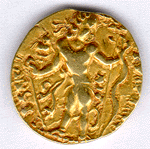
Vikramaditya or Chandragupta II
375-414 AD
Gold Dinar, Weight: 7.77 gm
Obverse: King holding Bow, looking right
Reverse: Laxmi sitting on lotus
MAC#4796 ff
Rare
Vikramaditya’s reign was perhaps the most prosperous and progressive reign in the Indian history. The contemporary Chinese traveler and Buddhist monk Fa-hein was struck with the prosperity of subject during Gupta rule. He has admired the royal palaces and houses for dispensing charity medicine. He speaks highly of system of Government.
Shown above is a beautiful example of his coin where King is holding bow, looking right. It is a rare coin as most of his coin depicts him looking left. Shown below is another example of Vikramaditya’s gold coin which shows him holding bow and arrow but looking left. Chandra (literally means moon) is written on obverse (below his arm). Also one can read Gupta on left side of coin. On reverse Laxmi is depicted, seated cross legged on lotus, holding flower in her left hand.
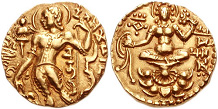
Vikramaditya or Chandragupta II
375-414 AD
Gold Dinar
Weight: 7.77 gm
Obverse: King holding Bow, looking right
Reverse: Laxmi sitting on lotusMAC#4796 ff
Rare
Vikramaditya minted seven distinct types of coins: Sceptre/standard type, Archer type, Chatra type, Chakravikrama type, horseman type, lion-slayer type and couch type. Shown below is another beautiful specimen of Vikramaditya where he is shown slaying a lion, an absolute beauty! The king is bare-bodied, a crest jewel on the forehead, curly hair falling on neck. He holds bow in right hand and strings it to ear by left hand to shoot at lion standing in front of him. The legend around read Narendrachandrah prathitaranorane jayatyajayyo bhuvi sinhavikramah. On reverse is Goddess Abmika-Laxmi nimbate, seated on lion, holding lotus in her left hand and noose in her right hand. The legend reads Simhavikramah (brave as lion).
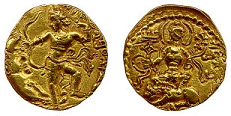
Vikramaditya or Chandragupta II
375-414 AD
Gold Dinar, Weight: 8.01 gm
Obverse: King is barebodied, a crest jewel on the forehead, curly hair falling on neck. He holds bow in right hand and strings it to ear by left hand to shoot at lion standing in front of him. The legend around read Narendrachandrah prathitaranorane jayatyajayyo bhuvi sinhavikramah
Reverse: Goddess Abmika-Laxmi nimbate, seated on lion couchant to left, holding lotus in her left hand and noose in her right hand. The legend reads Simhavikramah
Reference: BMC Plate 114, pl IX3 obverse; Altekar Bayana Plate, Finest animated style, broad flan
Very Rare in such condition
KUMARGUPTA I or MAHENDRADITYA (415-455 AD)
Vikramaditya was succeeded by his able son Kumargupta I. He maintained his hold over the vast empire of his forebears, which covered most of India except southern four states of India. Later he too performed the Ashwamedha Yagna and proclaimed himself to be Chakrawarti, king of all kings. Why he did not mint coins commemorating this event is not clear. Kumargupta also was a great patron of art and culture; evidence exist that he endowed a college of fine arts at great ancient university at Nalanda, which flourished during 5th to 12th century AD. Numismatic evidence suggests that during his reign the Gupta empire was at its zenith. His reign also saw tremendous creativity and thus a lot of variety in Gupta coinage. Kumargupta minted 14 distinct types of Gold coins, the largest of all Gupta rulers. Many of them, like Rhinoceros-slayer, Apratigha (parents crowning him as ruler) and Kartikeya or Peacock rider type (shown below) are unique in entire Indian numismatic history. He also minted two coin types, Tiger-slayer (shown below) and Lyrist, which his grandfather, Samudragupta minted briefly. These two types were discontinued during the reign Chandragupta.
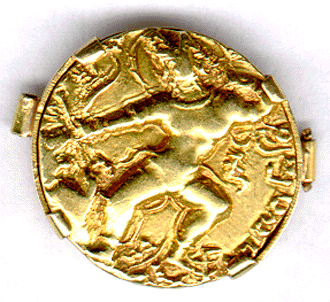
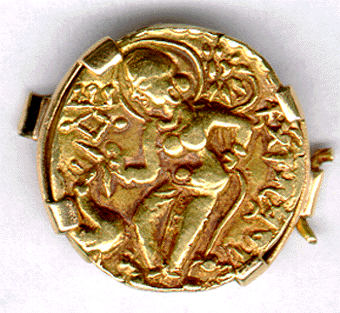
Kumargupta I
415-455 AD
Two Gold Dinars
Obverse: King shooting the tiger; Reverse: River goddess Ganga, feeding grapes to peacock
Weight (#1): 10.26 gm with mount
Reference: BMC Gupta#244, Altekar#1706ff; Weight (#2): 9.75 gm with mount
Reference: BMC Gupta# 243, Altekar# 1739ff, From the `Bayana Hoard’
Very Rare
Shown above are two of the finest known coins of Kumargupta. On obverse, king is shown wearing short sleeved coat, Dhoti, turban, earrings, necklace, armlets, wristles and trampling tiger by his right foot. He is shooting at it with his bow held in right arm, left hand drawing the string of the bow. The tiger is shown falling backwards with gaping mouth. The legends on obverse reads Srimama Vyagrahabala Parakramaha, his majesty having the strength and valor of a tiger. The reverse show goddess Ganga, nimbate, standing, slightly bent on Makara, the mythic crocodile, holding behind her a lotus with long stalk, in her left hand. She is shown feeding a peacock with fruit (very likely the grapes) . The goddess, the river Ganga is shown wearing a sari, bodice, earrings, necklace, armlets etc. The Legends written in Brahmi reads his official name, Kumarguptodhiraja. This tiger slayer type of coins are very rare and considered to be the master pieces of craftsmanship and truly represents the glory of Gupta empire and their brave emperors. Both the coins were recovered from the famous Bayana hoard.
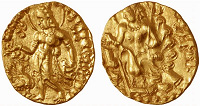
Kumargupta I
415-455 AD
Gold Dinar, Weight : 8.3 gm
Obverse: Kumaragupta, nimbate, standing left, feeding peacock from fruit bunch held in his right hand
Reverse: Karttikeya, nimbate, seated on his peacock, Paravani, left, sprinkling incense with his right hand on altar to right, and holding spear in his left hand.
Reference: BMC Guptas 250, (same reverse die); Altekar pl. XIII, 11; Bayana 1697
Very Rare
A hoard of at least 1821 (there were perhaps some more) gold coins belonging to Gupta dynasty was discovered in 1946 near village Bayana in the Bharatpur princely state. It was first noticed by boys scavenging for the brass shell casings of bullets fired by hunting party of Maharaja (King) of Bharatpur, Col. Brajendra Sawai Maharaja. This hoard was eventually acquired by Maharaja and a selection of coins from this hoard (mostly rare and beautiful coins) were picked up by Maharaja for making jewelry for members of Royal family. Rest of the coins of the hoard were graciously handed over to the first president of Modern India, Dr. Rajendra Prasad, who himself was a distinguished scholar of Indian history and philosophy. Now, the coins from this hoard can be seen in the National museums of India, New Delhi, Prince of Wales Museum, Bombay and Lalit Kala Bhavan in Varanasi. All the coins from this hoard were cataloged by Dr. Altekar, which remains the best reference book for Gupta gold coins. The two beautiful coins shown above are from the bracelet of the Queen of Bharatpur (either wife or aunt of Maharaja). The original bracelet had 9 (or 8) coins.
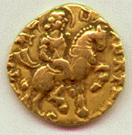
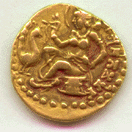
Kumargupta I
415-455 AD
Weight: 7.94 gm
Obverse: King riding the horse
Reverse: Goddess feeding grapes to peacock
Reference: MAC#4836
Scarce
Kumar is another name for Lord Kartikeya, general of gods whose vehicle was peacock. This is reflected in him minting coins depicting Kartikeya and peacock on many of his coins. Kumargupta also minted fine silver coins during his long reign. A exceptionally well preserved and well struck coin of him is presented below. It shows his bust in Kshatrapa style and reverse is formalized Garuda with spread wings. Garuda was royal symbol of Gupta dynasty and is seen on many of their coins. The legends on coin, written in Brahmi script reads Parama bhagvata rajadhiraj Shri Kumargupta Mahendraditya. Silver coins were mainly intended for circulation in western part of Gupta empire, which was originally incorporated by Great Vikramaditya (father of Kumargupta). Since the western region (modern Gujrat state) had well developed silver coinage, popularized by earlier Shaka rulers, the same tradition was continued, except the Shaka symbol of river and three arched hill was replaced with Garuda or peacock (Skandagupta introduced this symbol), on reverse. Unlike, the gold coins where an effort was made to show rulers on coins in their life-like form, silver coinage were more or less just standard reproduction without consideration for the ruler’s actual looks.
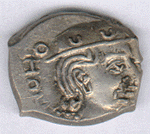
Kumargupta
415-455 AD
Silver Dramma or Rupaka
Weight: 2.17 gm
Obverse: Bust of King
Reverse: Stylized Garuda with spread wings
MAC#4845
SKANDAGUPTA (455-467 AD)
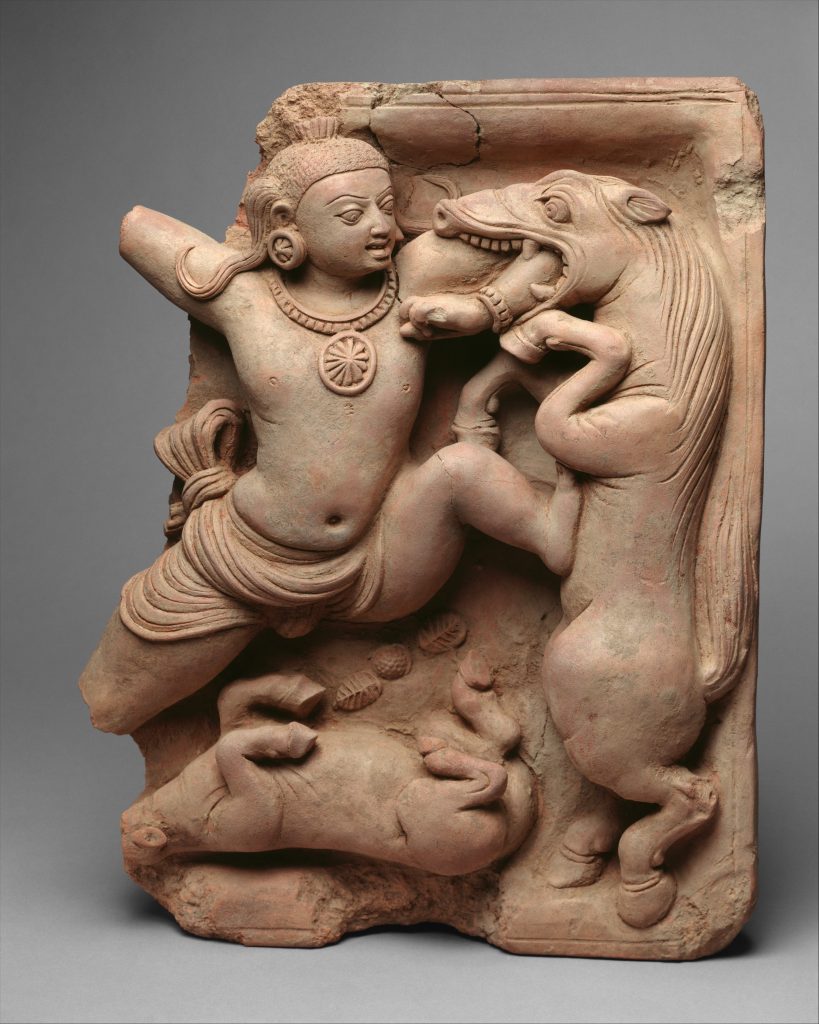
Skandagupta took over the Gupta empire, who too was named after Lord Kartikeya, whose another popular name is Skanda (a clever ploy by Kumargupta, naming son after himself?). Skandagupta and soon had to face with the formidable enemy, the Huns (Hepthalites). Unlike later Roman rulers, who succumbed to these Hunnic invasions, he successfully repelled their early invasions and proved to be able king and administrator in time of crisis. In process, he ensured the prosperity of Gupta empire, a single most achievement of this last great Gupta emperor.
Two rock instrption of Skandagupta has survived, one pillar inscription at Bhitari in Uttar Pradesh and second in Junagadh, Gujrat. Skandagupta in Junagadh rock inscription is described as `embraced by the goddess of wealth and splendor who is chosen by Sri-Laxmi, a goddess of wealth’. This theme is reflected upon his coins of King and Sri-Laxmi type, shown below. These rare coins show victorious king (his physical attributes are particularly visible, notice the musculature and not to mention, the swagger!) and his divine consort Sri-Laxmi (who was considered as his second wife waiting on him invisibly, what an audacity!!), standing beneath the imperial Garuda (a mythical hawk like bird) banner, which signify victories of Gupta kings over barbarian Huns. The king is shown to carry a bow and arrow while Sri-Laxmi is depicted with lotus in her left hand. The reverse shows Laxmi sitting on lotus, with legend Sri Skandagupta in Brahmi script.
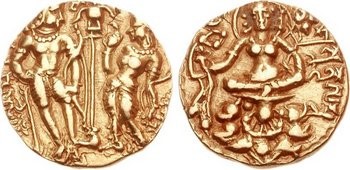
Skandagupta
455-467 AD
Gold Stater, 8.47 gms
Obverse: Skandagupta facing Sri Laxmi, lotus behind her,
Reverse: Goddess Laxmi seated facing on lotus, to right Brahmi legends
Reference: Altekar bayana XXXII 3; BMC [pl XIX 6-9]; MAC#4866
Since Eastern part of India (modern Gujrat) was also part of his empire, he minted silver coins. Shown below is his silver coin minted in Kshatrapa (Shaka) style. Reverse is stylized humped bull with inscription Param bahagvata Shri Skandagupta Kramaditya.
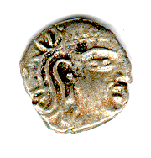
Skandagupta
455-467 AD
Silver Dramma
Weight: 2.1 gm
Obverse: Bust of King
Reverse: Bull sitting
MAC#4879-82.
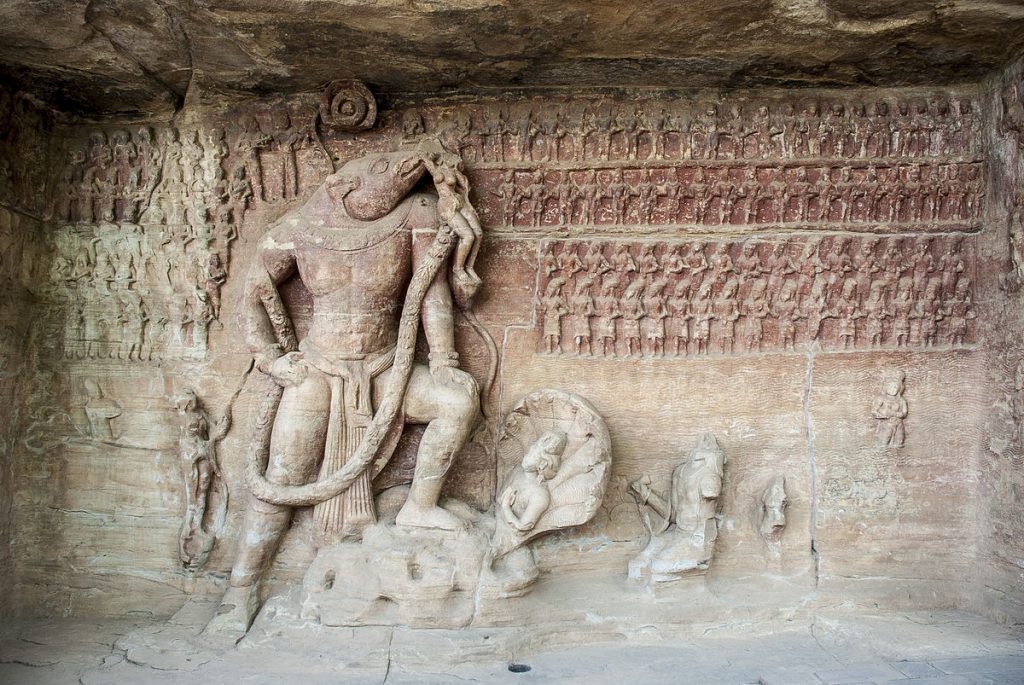

In spite of heroic efforts of SkandaGupta, Gupta empire did not survive long the shock it received from invasion of the Huns and internal uprising. Although there was some sort of unity till reign of the last king Budhagupta in the 6th century AD.
Kings of Gupta dynasty were the great patrons of art, culture, languages, mathematics and science. Unfortunately, very few monuments built during Gupta reign survive today. The best examples of Gupta art is found at Udaygiri caves (shown on left), where one can see inscription of Chndragupta II & Kumargupta. The examples of the Gupta art & architecture is also seen at Dashavatar temple, dedicated to Lord Vishnu, at Deogarh, Uttar Pradesh. It is the oldest surviving Hindu temple. Other temples built during Gupta era are, the Kankali Devi temple in Tigawa near Jabalpur, Madhya Pradesh, Vishnu Temple (and colossal Varaha boar statue) at Eran, Shiva Temple at Bhumara, Parvati Temple at Nachna, Gupta temple at Sanchi and Jagannath temple at Bhitargaon. The Bhitargaon temple also has unique distinction of the oldest surviving brick/terracotta temple. These temples together greatly helped Alexander Cunningham to identify characteristic markers of ancient Hindu temples and to chronologically place early Indian architecture.
Many of the finest paintings of ancient India were executed during Gupta period (320-600 AD), the best example being the murals at Ajanta Caves. The colorful and vibrant murals at Ajanta are famous not only for the meticulously observed details of nature and the urban landscape, including architecture and furnishing, elegant attire and alluring ornaments but also for perceptive delineations of a variety of human characters, expressions and moods. Ajanta caves which are located at western Maharashtra were part of local Vakataka kingdom which had matrimonial relations with imperial Guptas. The rich and sensuous life at Vakataka court and of Gupta India in general is realistically displayed in these murals.
The Iron Pillar, 24 feet high and weighing 13,000 lbs, located at Meharulli, Delhi is a fine example of the great scientific achievements of Gupta reign (shown above). In spite of being 1600 years old, this Iron Pillar is still standing without any rust. It is widely believed that this pillar was erected by Chandragupta II, Vikramaditya.
The greatest Sanskrit poet Kalidasa who wrote Meghdoot and Kumarsamhita lived during Gupta period and suggested to be in Vikramaditya’s court (although this is doubtful). He also wrote another five-act Sanskrit play, Vikramōrvaśīyam (Urvashi Won by Valour), which is based on the a story of king Pururava who falls in love with Urvashi, an Apsara (a celestial nymph). The works of Kalidasa exemplify the literary craftsmanship of this period. The Panchatantra, a collection of fables was another popular work. The Sanskrit Dramas Mrichchhakatika and Mudra Rakshasa were also written during Gupta reign.
Celebrated astronomers Aryabhatta, who calculated the correct value of pi in AD 499, lived in this period. He also calculated the length of the solar year as 365.358 days and later postulated that the Earth was a sphere, rotating on it’s own axis and revolving around the Sun, as well as the exact cause of eclipses. Varahamira showed the importance of decimal system in treatise Bhrihatasamhita, also flourished during Gupta period. The law books of Bruhaspati, Narada and many sections of Puranas (Sanskrit scriptures) were also written in this glorious period.
The Gupta era (329-650 AD) was also golden age for Buddhist art. The political unity of India brought by Gupta emperors, in turn initiated an artistic unity which transcended regional boundaries. Uniform artistic standards came into effect which were set chiefly by workshops in Mathura and Sarnath, which produced some of the finest specimen of Buddhist art. Gupta style of art which was marked by a finished mastery in execution and a majestic serenity in expression was spread to other countries and greatly influenced Buddhist art all over Asia.
Administration structure during the Gupta period was exceptionally good in spite of large empire. In the Gupta administration, the governors of the provinces were more independent as compared to the Mauryans. Land taxes increased in number. Trade with the Roman empire declined after the third century AD. Indian merchants began to rely more heavily on the south-east Asian trade. Instead of Roman gold, it was the South-East Asian countries which fueled Indian need for precious metals.
